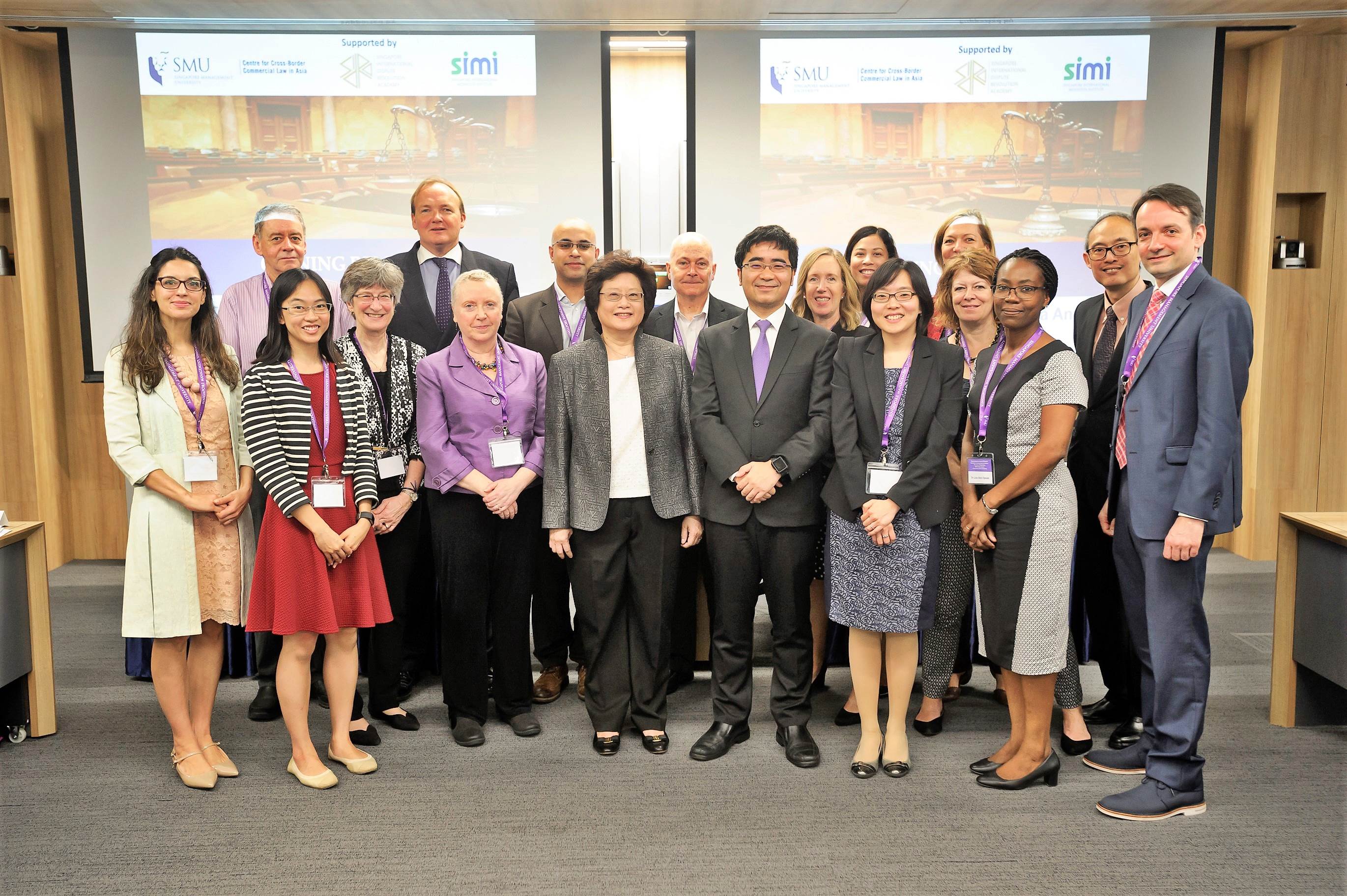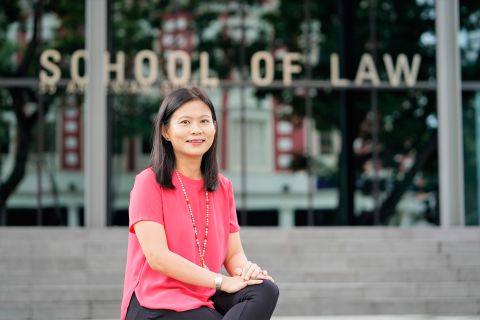
By Juliana Chan
SMU Office of Research & Tech Transfer – A trip to the courthouse used to be a zero-sum game – one emerged either victorious from the judge’s verdict, or defeated and feeling rather miserable. But over the past few decades, the role of the civil justice system has evolved from what used to be a win-lose relationship through adjudication, to one that is win-win through mediation.
Hoping to lead change in the culture of deal-making and dispute resolution is the Singapore Management University’s (SMU) Centre for Cross-Border Commercial Law in Asia (CEBCLA). As part of these efforts, CEBCLA organised a legal forum, titled ‘Expanding the Scope of Dispute Resolution and Access to Justice: The Use of Mediation within the Courts’, with the support of the Singapore International Dispute Resolution Academy (SIDRA) and the Singapore International Mediation Institute (SIMI).
The two-day forum, held on 12-13 March 2018, was convened by Assistant Professors Dorcas Quek Anderson and Eunice Chua of the SMU School of Law, and attended by judges, practitioners, academics and policy makers from Singapore and overseas, many of whom have participated in mediation in various capacities.
In her opening remarks, guest of honour The Honorable Justice Belinda Ang, chairperson of the Singapore Mediation Centre (SMC), described the history of private mediation in Singapore, from the mooting of the idea for the SMC in 1996 by the then Attorney General Chan Sek Keong, to SMC’s handling of a record 538 mediation matters worth over S$2.7 billion in 2017.
“The use of mediation in the courts has been calibrated to ‘fit the forum to the fuss’, to tailor the needs of different types of cases and disputants. It is a uniquely Singaporean system that works, consistent with the broader approach of offering different options to people with varying social and economic needs,” Justice Ang said.
A clearer definition of mediation
With the integration of mediation into the dispute resolution system, parties now have the option of a fair, cost-effective and efficient resolution to their conflicts, said four speakers at the forum’s first panel, ‘Evaluating the Court’s Expanded Role in Dispute Resolution’, moderated by Associate Professor Joel Lee of the National University of Singapore Faculty of Law.
“Sixty percent of Quebec citizens believe that an agreement reached outside the courts is fairer than a judgement rendered during a trial," said Professor Jean-François Roberge, director of the dispute prevention and resolution programme at the University de Sherbrooke, adding that only 47 percent believe that decisions made by judges are fair. Professor Roberge was citing statistics from the 2016 Survey on Access and Perception of Justice in Quebec, commissioned by the Quebec Department of Justice.
Taking an ethical angle to the discussion of judicial mediation, Dr Lola Akin Ojelabi, a senior lecturer at the La Trobe Law School, pointed out that party self-determination was a good reason to support judicial mediation. “Unlike litigation and other dispute resolution processes, mediation provides parties with the power to decide how best to resolve their dispute.”
But more work needs to be done to improve the overall quality of mediation, agreed the panel. As a start, the term ‘mediation’ is sometimes improperly defined by users, leading to something termed process confusion, said Professor Tania Sourdin, dean of the University of Newcastle Law School in Australia.
“In the mediation world, we call everything ‘mediation’. It is like calling all restaurant types ‘food’, when we actually mean to distinguish that you have Singaporean cuisine, Indian cuisine and Chinese cuisine,” said Professor Sourdin.
When judges wear multiple hats
Open and transparent proceedings are core features of modern courts, where judges remain impartial to a case and do not prejudge it. With mediation now thrown into the mix, a curious phenomenon that has arisen in some jurisdictions is one where the judicial officer mediating the case (in court or behind closed doors) goes on to hear it.
“I’m often surprised when I talk to judges who have actually gone on to hear a matter after mediating or conducting a judicial dispute resolution process,” said Professor Sourdin, who pointed out that the relationship between the judge and one party to a dispute can be altered as a result of a private meeting.
To address this concern, Professor Nancy Welsh, director of the dispute resolution programme at the Texas A&M University School of Law, recommended a procedural safeguard called blind consent, which is practiced in the US with regard to federal magistrate judges.
“What this means is that before the judge goes on [from mediation] to their next different role, parties are given the opportunity to elect whether or not they want the judge to proceed to that role,” Professor Welsh said, noting that a clerk would ask the question instead of the judge, as either party may find the judge “very intimidating”.
Making mediation a must
In both the US and Singapore, the courts may require or strongly encourage the use of mediation, in what Professor Welsh called an exercise of their “coercive power”. As part of her research, Professor Welsh found that judges in the US overwhelmingly enforced mediated settlement agreements so as not to jeopardise the mediation process.
“If the courts are lending their coercive power to mediation, they may want to ensure that mediation is a trustworthy process,” said Professor Welsh, arguing that courts should also be obligated to provide meaningful procedural safeguards when they mandate or strongly encourage mediation.
Besides the idea of blind consent discussed earlier, she also recommended safeguards such as supervision or evaluation of the mediation process, establishing a grievance procedure for parties to give confidential feedback, disciplinary procedures for errant behaviour, and potentially regulating the field.
Another common theme that came up among the speakers was the idea that judicial officers would benefit from some form of training in mediation. “I can’t tell you how many times I’ve gone into court and heard about judges who have no training and call themselves mediators,” said Professor Sourdin. “I have a firm view that all judges should be trained in mediation, but not all judges should mediate.”
In closing the session, Professor Lee provided further nuance to the panel discussion by discussing recent shifts in judicial culture and exploring concerns such as whether the courts were “allowing the tail to wag the dog” when it came to mediation.
“One of the concerns as a practitioner and an academic is to ensure that justice, voluntariness and transparency don’t get trampled under the wheels, in the name of efficiency,” Professor Lee said.
Back to Research@SMU Issue 53
See More News
Want to see more of SMU Research?
Sign up for Research@SMU e-newslettter to know more about our research and research-related events!
If you would like to remove yourself from all our mailing list, please visit https://eservices.smu.edu.sg/internet/DNC/Default.aspx

